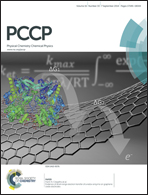On the existence and characteristics of π-beryllium bonds
Abstract
The existence of π-beryllium bonds explains the stability of the complexes between ethylene and acetylene and BeX2 (X = H, F, and Cl) derivatives. These linkers involve a significant charge transfer from the πCC bonding orbitals into the empty p orbitals of Be and to a much smaller degree into the σBeH* antibonding orbitals. The significant deformation of the BeX2 moiety and the slight deformation of the unsaturated hydrocarbon result in distortion energies as high as the dissociation energy of the complex. The π-beryllium bonds are about four times stronger than conventional π-hydrogen bonds and even stronger than the strongest π-hydrogen bond reported to date in the literature. The topology of their electron density is characterized as being very flat in the bonding region between the π-system and Be, which leads to topologically unstable structures close to catastrophe points. Among the functionals considered in our study M06 is the one that leads to values in better agreement with CCSD(T)/aug-cc-pVTZ calculations used as a reference. B3LYP underestimates some interactions, whereas M06-2X overestimates all of them. MP2 also yields good agreement with the CCSD(T) method.


 Please wait while we load your content...
Please wait while we load your content...